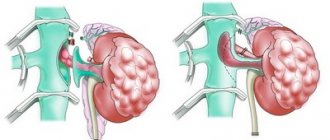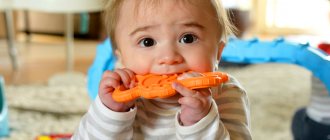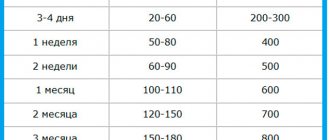Both in adulthood and in childhood, various digestive problems may arise due to the negative impact of internal and external factors. In any case, it is imperative to establish the cause of constipation and choose effective treatment methods. Decay products that stagnate in the rectum gradually begin to poison the body and negatively affect the functioning of important organs and systems. Treatment must be timely and comprehensive to restore normal functioning of the digestive system, especially in newborns.
Constipation and its symptoms
Constipation is considered to be the absence of bowel movements for two days or more, or difficult, irregular bowel movements, characterized by straining, pain, and hard stool.
Normally, an 8-month-old baby should walk “big” 1-2 times a day, but we must not forget about rare exceptions when, due to the physiological characteristics of the child, stool is observed once every two days. However, even with regular bowel movements, you need to pay attention to the type of feces: dry, formed in the form of individual lumps stuck together or dark-colored sheep feces - this is the main sign of constipation.
In addition, the baby may have abdominal pain that goes away after bowel movements. Fresh blood may appear, indicating microtrauma of the rectum. Some children push hard without any result. Sometimes vomiting occurs.
Constipation must be treated. In some cases, it goes away on its own, but most often parents are required to take action so as not to start the problem and not to aggravate it.
Symptoms
It is not difficult to recognize constipation, especially in children: the frequency of stool is always under the control of the parents. Older children are often embarrassed to talk about a problem with the intestines, they endure it, and bring the condition to a critical point. Only with severe bloating and intestinal pain do parents notice that the baby is constipated.
Main symptoms of constipation:
- rare stool/complete absence for several days;
- pain during defecation;
- passage of hard feces with blood;
- after defecation, it seems that there are remains of feces in the intestines;
- bloating, pain in the intestinal area;
- change in stool consistency;
- in severe cases - deterioration in general health, headaches, lack of appetite, problems sleeping.
Causes of constipation
Constipation in an 8-month-old child can occur for the following reasons:
- insufficient drinking regime, as a result of which the stool thickens and becomes hard;
- introduction of foods into complementary foods that have a strengthening effect on stool;
- low content of coarse fiber in the diet;
- little physical activity of the baby;
- rectal fissure;
- lethargy of the digestive tract;
- stress factors;
- adhesions or tumor formations;
- helminthiasis;
- Hirschsprung's disease;
- allergic reactions, diathesis.
Types of constipation
In medicine, there are two types of constipation in children:
- Atonic. It is characterized by bloating of the baby's abdomen due to the large volume of feces in the intestines. There is no urge to go to the toilet. Defecation occurs once every 2-3 days, which requires significant effort. Pain in the lower abdomen and a feeling of fullness may appear. The first stool has a very dense structure, sometimes with blood streaks.
- Spastic. In this condition, frequent intestinal spasms are observed, causing spasmodic pain. Feces come out in dense fragments. There is increased gas formation and, in some cases, belching. The overall tone of the body decreases.
By their nature, the following types of constipation are distinguished:
- Congenital - due to the anatomical features of the rectum, developmental defects and congenital diseases;
- Functional – for disorders of the gastrointestinal tract;
- Acquired - due to the development of neoplasms.
Diet for constipation in children: at 3, 2, 5 years old, menu, recipes, nutritional therapy, for chronic
Difficulty with bowel movements (or constipation) causes severe discomfort to patients of any age. What does the clinical picture of constipation look like? Why do children have difficulty moving their bowels? How to organize your diet correctly to cope with constipation, improve bowel movements and prevent problems? These questions worry many parents.
About childhood constipation
Difficulties with defecation in children develop regardless of the age and well-being of the family, so many mothers face this problem. Most often, constipation worries newborns and children under one year old, which is associated with the period of adaptation of the gastrointestinal tract. But poor bowel movements are also familiar to parents of older children. A child may have constipation:
- functional;
- inflammatory;
- organic.
Most often, the first type of constipation is diagnosed in this category of patients. Functional constipation develops for many reasons, including disturbances in the water-electronic balance, psycho-emotional stress, errors in diet, intoxication, etc.
Recipes, menus and diet products
- increasing the interval between bowel movements;
- reducing the amount of feces passed;
- defecation is accompanied by redness of the face and crying (in infants);
- sitting on the potty for a long time;
- compaction of feces;
- bloating and abdominal pain.
With prolonged constipation, a child may develop problems with appetite. Against this background, infants often stop gaining the required weight, and older children lose several kilos. Often, difficult emptying is accompanied by rupture of the anus, which is manifested by crying and the presence of blood in the feces.
The easiest way to notice is the acute type of constipation. It is characterized by a complete absence of stool for up to 2–3 days or more. Such constipation poses a particular danger to the child’s health, as it is often accompanied by intoxication and can result in the formation of a fecal impaction.
How can you tell if your child is constipated?
According to the World Health Organization, constipation is defined as prolonged stool retention and difficult and insufficient bowel movements.
Russian pediatricians indicate that a child should have bowel movements at least once every 2-3 days and the consistency of stool should not be changed.
European experts are of the opinion that if there is no bowel movement for more than three days, but the baby does not show complaints and his behavior has not changed, this condition is not regarded as constipation.
Doctors adhere to the following diagnostic criteria when assessing the condition of a small patient:
- lack of a regular bowel movement rhythm for several days;
- the need for prolonged and strong straining;
- hard, lumpy stool that resembles sheep feces;
- painful bowel movements;
- the output of a scanty amount of feces of increased density;
- feeling of incomplete emptying of the intestines.
The combination of four of the six indicated signs allows you to assess the situation and confidently make a clinical diagnosis.
Diagnosis of constipation
In order to accurately identify the cause of constipation, a comprehensive diagnosis of the problem is carried out. First of all, the doctor collects an anamnesis, which includes:
- finding out the time of onset of constipation and the age of the child at this moment;
- determination of the clinical picture;
- daily diet;
- psychological aspects in a child’s life;
- degree of physical activity;
- painful bowel movements;
- carried out preventive measures.
After collecting anamnesis, the doctor conducts an external examination of the child. During palpation, he determines the functional state of the muscle group in the sphincter area, the presence of fecal stones, fissures or neoplasms. At this stage, laxatives, pro- and prebiotics may be prescribed for constipation.
If necessary, additional studies will be prescribed, the general complex of which includes the following:
- Ultrasound of the abdominal cavity and pelvic organs;
- stool analysis for dysbacteriosis;
- fecal analysis for helminths;
- coprogram - examination of feces to determine the functioning of digestion;
- Colodynamic study - determination of the functional state of the rectum;
- sphincterometry - study of the function of the internal and external sphincter;
- Anorectal manometry - determination of the tone of the anorectal muscles and their work during bowel movements.
- enterocolonoscintigraphy – study of intestinal motor function;
- endoscopy – to examine the condition of the intestinal mucosa;
- X-ray of the lumbosacral region - to identify pinched nerve endings.
This list of studies is provided for general information about methods for diagnosing constipation in children 8 months old. In most cases, laboratory tests of stool/blood and ultrasound are sufficient to correct stool. The examination is carried out with the participation of a pediatrician, gastroenterologist or pediatric proctologist.
Diarrhea in a 9 month old baby
Loose stools in a 9-month-old baby are also common and can be caused by various reasons. First of all, let’s decide when the baby can be diagnosed with diarrhea. Pay attention not to the number of bowel movements per day, but to their consistency. When a baby has diarrhea, the stool may be loose, watery, mixed with mucus, blood and even pus. In this case, you need to consult a doctor, as severe diarrhea can even threaten the baby’s life.
What are the main causes of diarrhea in young children under one year of age? This is the introduction of a new type of complementary food (for example, kefir), errors in the diet of a nursing mother, food poisoning and intestinal infections, teething syndrome, intestinal dysbiosis. In addition, any stress in the life of a small child can also lead to bowel dysfunction. Diarrhea accompanies various diseases from acute respiratory viral infections to pneumonia. In this case, other symptoms of the disease must be present. If diarrhea in a 9-month-old child is diagnosed without fever, it is most likely due to teeth, nutritional errors, enzyme deficiency or dysbiosis.
If you know the cause of diarrhea, eliminate it (for example, remove a new type of complementary food for a while). The most important thing is to monitor the replenishment of fluid in the child’s body. When a nine-month-old baby has diarrhea, what to do first: offer him water more often, at least a teaspoon every half hour. In case of severe diarrhea, you will need a solution of “Regidron” or similar drugs that perfectly replenish the water-salt balance. To cleanse the body of toxins and normalize stool, Smecta, Enterosgel or Filtrum are suitable. Rice water helps to improve the baby's stool. In addition, the doctor will probably prescribe medications for the child to normalize the intestinal microflora.
Related tags: Comment Interesting? Subscribe to the best materials in the weekly newsletter Get to know yourself Test: 15 questions Can you laugh at yourself? 2426 All tests You will be interested in Health Treatment of diarrhea during pregnancy 779 Health Diarrhea and constipation in children 8 years old 7358 Health Diarrhea and constipation in a child 7 months old 1710 Health How to stop diarrhea in a child aged 1 year? 6115HealthDiarrhea and constipation in children 10 years old 9764HealthDiarrhea and constipation in a child at 6 months957All articlesComments ()
Content:
Causes of constipation Why constipation is dangerous Treatment of constipation Treatment of constipation in children with MICROLAX®
In children under one year of age, constipation is the most common bowel disorder. We can talk about constipation if a 9-month-old child has not walked for more than a day. If defecation is regular, but the stool is hard and the process causes pain in the child, we are also talking about this unpleasant phenomenon. The norm for young children is to go to the toilet after each feeding. An examination with a doctor will help you understand the causes of constipation in each specific case. However, there are a number of reasons that are the most common.
Treatment of constipation
If an 8-month-old child has constipation, what should I do? Treatment is primarily aimed at eliminating the root cause. In the case of congenital and acquired forms of hemorrhoids, the surgical method is usually used. But in the overwhelming majority, the cause of constipation is digestive disorders, which is easily explained in the case of children 8 months old. Usually the problem is caused by a specific food and fluid deficiency. These factors need to be eliminated first.
Acute constipation is quite difficult for children, with pain, crying and anxiety. Here, parents must take measures to alleviate the condition of the baby. Helpful:
- Cleansing enema with boiled water at room temperature. For an 8-month-old child, it is enough to inject 50–100 ml into the anus. water and after a few minutes let the child have a bowel movement. You can add 1 spoon of glycerin solution or chamomile decoction to the water you use.
- Glycerin suppositories for children. Their use is permissible from infancy, but it is necessary to administer not the entire suppository, but ¼ or 1/3 of it. After administration, you need to wait a few minutes and then put the baby on the potty.
- Abdominal massage. Without exception, all pediatric gastroenterologists talk about its benefits for children of all ages. During the massage, movements should be circular and performed clockwise, or unilateral along the line of the oblique abdominal muscles. It is useful to perform the exercise by pressing the bent legs to the stomach, while controlling the pressure. Such simple actions activate intestinal motility and promote the movement of feces towards the exit.
- Microclysters "Microlax" have already been appreciated by many mothers. This drug has a convenient form in the form of a tube with a long tip, the contents of which (5 ml) are administered to the baby. The result can be expected within an hour. The only correction: Microlax can cause a feeling of discomfort and burning in the anus for many people, including children. Therefore, it should be used as a last resort and on the recommendation of a doctor.
If your child's constipation becomes regular, the doctor will prescribe medication.
Drug treatment of constipation
The most popular remedy for constipation is Duphalac. It can be given to the child in the form of syrup, diluted with a small amount of water. The drug is based on the action of lactulose (a derivative of milk sugar), which is broken down by beneficial intestinal bacteria, promoting their active growth. As a result of intake, the feces soften, increase in volume and easily pass out. Duphalac has a cumulative effect, so results should be expected in 3-7 days. Indicated for children under one year of age.
Basic treatment methods
The treatment method for constipation depends on the type and causes of the problem. It is important to take into account the child’s age, type of nutrition, the nature of preschoolers and schoolchildren, and the general condition of the body.
Main methods of treatment:
- anatomical constipation requires surgical intervention;
- For constipation, use laxatives as rarely as possible so that there is no irritation of the mucous membrane and the intestines do not become “lazy”;
- microenema Microlax is a good remedy for constipation in children if the problem occurs infrequently;
- to improve intestinal motility, doctors often prescribe Duphalac;
- changes in diet and diet for constipation. Eating black bread, bran, prunes, boiled beets with butter, oatmeal, carrots, and fermented milk products promotes rapid bowel movements and soft consistency of stool;
- When breastfeeding, the mother must follow a diet. Prohibited: rice, semolina porridge, onions, garlic, legumes, cow's milk. You should not eat white cabbage, mushrooms, black bread, or drink strong tea;
- for artificial babies, special mixtures with probiotics, lactulose, and oligosaccharides are recommended;
- In the morning, give the children vegetable oil (sterilized in a water bath). Dosage – from 2 drops to 1 tsp. according to age;
- Massage for constipation is another way to reduce pain and improve intestinal motility. Stroke your tummy clockwise without pressing hard, but so that you can hear that you are doing a massage.
Prevention of constipation in children
To prevent constipation, you must follow all the rules for introducing complementary foods. It is important from this age to teach the baby to drink purified water, as well as sit on the potty to develop a conditioned reflex to defecate. The child’s motor activity should be encouraged; it would not be amiss to give him a course of restorative massage. The atmosphere in the family should be warm and loving.
Source
Both in adulthood and in childhood, various digestive problems may arise due to the negative impact of internal and external factors. In any case, it is imperative to establish the cause of constipation and choose effective treatment methods. Decay products that stagnate in the rectum gradually begin to poison the body and negatively affect the functioning of important organs and systems. Treatment must be timely and comprehensive to restore normal functioning of the digestive system, especially in newborns.
A child at 7, 8, 9, 10 or 11 months has constipation: what to do at home
Stool upset in a baby under one year of age is quite common. It may manifest itself in the form of diarrhea or constipation. The latter is much more common. The reasons for difficulties with bowel movements can be different, most often it is due to poor nutrition. A consultation with a pediatrician will help solve the problem.
Stool upset in children is a common occurrence.
If a child is constipated at 7-11 months
Young children, starting from six months, often have digestive disorders. If a 6-month-old child has constipation, what to do, the doctor will tell you. Prolonged absence of bowel movements is dangerous because:
- Leads to general intoxication of the body;
- Causes dehydration;
- Causes severe discomfort to the child, the baby will cry and worry;
- It can be the beginning of serious illnesses.
That is why parents should monitor the baby’s stool and notice alarming symptoms in time (for example, the baby may cry for a long time, raising his legs to his stomach).
Stool norms at 7-11 months
Constipation in a 6 month old baby - types and causes
Since each child is individual, there are no norms for bowel movements at this age. Children may go to the toilet daily or once every few days. The last option is the norm if:
- The baby has a good appetite;
- He is active and cheerful;
- There is no weight loss;
- The child is not bothered by intestinal colic or abdominal pain.
If a prolonged absence of bowel movements leaves the baby uncomfortable, it is most likely constipation, which requires treatment.
Types of constipation at 7-11 months
Constipation in a 2 month old baby - types and main causes
At this age, babies experience physiological constipation - a prolonged absence of stool that does not cause discomfort.
This problem is temporary and is associated with underdevelopment of the digestive system or overfeeding the baby.
However, when the lack of stool is accompanied by abdominal pain and colic, the problem is pathological. Rules of conduct in this case:
- Do not give any medications before consulting a pediatrician;
- Do not give the baby laxatives;
- Massage the child's abdomen in a clockwise direction;
- Place the baby on his stomach more often, this will activate intestinal motility.
Sometimes stool disorders are associated with serious congenital pathologies of the gastrointestinal tract. In this case, consultation with a pediatric surgeon is required. Constipation in a 7 month old baby is not uncommon. Pathology is less common than the normal variant.
Problems with bowel movements are often caused by sluggish bowel movements
Causes of constipation at 7-11 months
If a 7 month old baby has constipation, what to do, the doctor will answer. He will also determine the type of bowel disorder. The most common causes of the problem are:
- Using the wrong formula;
- Too early and rapid introduction of complementary foods;
- Individual intolerance to certain foods;
- Reaction to new dishes.
Constipation in a 3 month old baby - types and how to help
Young children may also have intestinal spasms caused by stress. In this case, consultation with a neurologist is required. In most cases, you can find out the cause of the bowel disorder by observing your child and monitoring his daily diet.
For babies prone to long-term absence of stool, it is recommended to have vegetable puree as their first complementary food. Vegetables activate intestinal motility due to the content of coarse plant fiber.
Zucchini, broccoli and cauliflower are especially beneficial. Potatoes and bananas, on the other hand, can cause a delicate problem. You should definitely remember this when creating a diet for your baby.
Pumpkin also has a slight laxative effect.
Interesting. If the baby continues to actively suckle at the breast along with complementary foods, the cause of stool disorder may be the nutrition of the nursing mother. Mom should not get carried away with smoked and fried foods, as well as spices and fast food.
How to deal with constipation
Constipation in an 11-month-old child can be treated by adjusting the diet. The same applies to young children, starting from six months. Constipation in a 7 month old baby, what to do at home:
- Do not overfeed the baby;
- Let your child drink as much water as possible;
- Stimulate active movements of the baby;
- If the baby is very worried, you can insert a gas tube or do an enema.
Active physical movements help a lot. To do this, the baby must be placed on his stomach and encouraged to crawl. Physical activity “starts” the work of the intestines.
Starting from 9 months, when the child’s diet already includes fermented milk products, you should give your baby kefir and yogurt daily.
They contain probiotics and gently normalize stool, having a gentle effect on the digestive system of the infant.
It is strictly forbidden to give your child fermented milk products intended for adults or children over three years old - they may contain preservatives that cause allergic reactions.
A clockwise abdominal massage is considered a fairly strong remedy against impaired intestinal motility. The movements must be strong and precise.
Evening bathing has a relaxing effect on the intestines, especially if the child actively moves his arms and legs in the bath.
All these simple remedies will help you safely cure stool disorders without using laxatives or visiting a doctor. The main thing is to carry out treatment and prevention daily.
Do not get carried away with enemas, the intestines should work independently
Attention ! One of the effective folk remedies against childhood constipation is considered to be a small piece of soap carefully inserted into the baby's anus instead of an enema. However, you should not listen to the advice of “wise” grandmothers - such treatment will not be effective.
Prevention of the disorder
To prevent the disorder, it is necessary to reduce the consumption of foods that contribute to a long-term absence of stool (pears, bananas, potatoes, rice porridge).
Products recommended for consumption are plums, apples, and all types of cabbage. Prunes provide an excellent relaxing effect.
However, you should not get carried away with it so that constipation does not turn into diarrhea, otherwise you will have to treat another disease.
The more fluid a breastfed or bottle-fed baby drinks at home, the better his intestines work. Children from six months of age who are receiving complementary foods must drink water every day. Water helps cleanse the body and flushes out all harmful substances from it, so its importance in baby food is invaluable.
If a child of seven to eleven months does not go to the toilet for a long time, do not panic. It is possible that this is only a temporary phenomenon. However, if constipation recurs frequently and causes discomfort to the baby, it is necessary to urgently find out the cause of its occurrence in order to help the baby. To do this, you must undergo a medical examination and diagnosis.
Source: https://kpoxa.info/zdorovie-pitanie/zapor-7-11-mes-rebenka.html
Signs of constipation
Constipation can be diagnosed in a baby at 8 months if there are problems with the natural process of bowel movements within two days. This may be difficult or complete absence of bowel movements.
In addition, babies generally sleep poorly, their appetite worsens, and pain appears in various parts of the abdomen. During defecation, the child begins to strain, blush, cry and scream.
The stool has a dense consistency. Evacuation does not occur completely, with great difficulty for the child. These are the first signs of a digestive problem. It is necessary to help the child restore normal bowel movements and eliminate the symptoms of constipation.
It is best to contact a pediatrician who will conduct a full examination of the baby, establish an accurate diagnosis and select the most effective treatment methods.
Symptoms
The presence of a disease can be determined by some reactions of children and various signs of their behavior:
- They sit on the potty for a long time, beat their feet on the floor, often the process is accompanied by screams and tears
- They generally refuse to sit down to relieve themselves.
- They “protect” the tummy (during play and pranks), since an unsuccessful touch can cause pain and discomfort.
Causes of constipation
Problems with bowel movements in an eight-month-old baby may occur for the following reasons:
- A lack of fluid in the body leads to hardening and stagnation of feces in the colon.
- Acquaintance with new products that are characterized by fixing properties. A child's body needs more time to adapt to new food. That is why it is necessary to introduce new products gradually, starting with minimal doses. In addition, it is necessary to monitor the reaction of the baby’s body.
- Lack of products containing coarse fibers and fiber. It is this kind of food that cleanses the stomach of waste and toxins, and also prevents the appearance of congestion in the colon.
- A sedentary lifestyle leads to weak intestinal muscles.
- Anal fissures.
- Serious diseases of the rectum.
- Allergic reaction to food or medicine.
- Long-term drug treatment, which led to disruption of the normal intestinal microflora.
Prevention of childhood constipation
To avoid digestive problems, follow these simple recommendations:
- First of all, you need to follow the drinking regime. If the baby is breastfed, be sure to also give water and juices to avoid hardening of the stool.
- The daily diet should include fiber, which cleanses the stomach of waste and toxins.
- Physical activity. Kids need to move a lot so that all muscle groups work. You can sign up for the pool, do gymnastics or massage.
Types of constipation
Constipation in an 8-month-old baby can be of the following types:
- Atonic. A feature of this type of constipation is an increase in the volume of feces, which leads to bloating. In addition, defecation may be delayed for three days, pain in various parts of the abdomen and blood in the stool are possible.
- Spastic. In this case, the feces have a fragmented structure. In addition, sharp and severe spasmodic pain may occur. The general condition and well-being worsens.
Constipation can also be divided into the following groups:
- Congenital. In this case, there is an irregular shape of any organ of the digestive system, for example, the rectum.
- Functional. Malfunction of the gastrointestinal tract.
- Purchased. There is a consequence of the occurrence of various intestinal diseases, for example, the formation of a tumor.
What is constipation
Malfunctions of the intestines, in which children cannot calmly and painlessly empty their intestines. In severe cases, stool is absent for two to three days, sometimes for about a week or more.
Danger of constipation:
- poisoning of the body with decay products;
- hardening of feces, irritation of the intestinal walls;
- when dense feces are released, a crack in the rectum appears, bleeding occurs, and severe pain is felt during defecation;
- With frequent constipation, the child has to push hard and spend a long time in the toilet. The result is hemorrhoids, psychological stress, nervous disorders;
- bloating appears, intestinal activity is disrupted, and digestive problems develop.
Normal stool frequency:
- from the neonatal period to six months. From two times a day, the stool is soft, puree-like;
- from 6 months to one and a half years. No more than twice a day (the mass is denser, well-formed);
- after 3 years. The normal frequency of bowel movements is at least three times in 7 days;
- children 6–10 years old. The norm is from 4 times a week;
- teenagers. Bowel movements – 5 or more times during the week.
How to recognize and how to treat colic in newborns? We have the answer!
Read about how to properly potty train a child at this address.
The danger of constipation for children
First of all, you need to understand that if a child is constipated, then all important organs and systems automatically suffer.
- Decay products in the rectum begin to release toxic substances that negatively affect the entire body. General health worsens.
- Congestion in the rectum can lead to cracks, bleeding and hemorrhoids.
- Weakening muscles can lead to rectal prolapse.
- The absorption of nutrients from food deteriorates.
So, in order to prevent complications and exacerbation of existing diseases, it is necessary to establish the cause in time and eliminate constipation.
What are the dangers of constipation?
Difficulty in defecation is not as harmless as it might seem at first glance. Constipation can cause serious health problems:
- toxins, finding no way out, will begin to be absorbed by the intestinal walls, enter the bloodstream and accumulate. This will affect the general condition of the child - the appetite will worsen, the baby will become less active;
- if toxins accumulate in the body for a long time, then immunity will noticeably decrease and the child will be susceptible to colds and viral diseases;
- constipation can also lead to injury and inflammation of the intestinal walls.
Treatment of constipation
What should you do if your 8 month old baby is constipated? This question worries many modern parents who care about the health of their baby. If the cause is pathological changes in the body or diseases such as hemorrhoids, then treatment is carried out through surgery. Otherwise, you can solve the problem at home if constipation is associated with a malfunction of the digestive system.
So, we offer several methods for restoring normal bowel movements in children:
- In emergency cases, you can do a cleansing enema. Plain water or chamomile decoction is suitable for this. For an eight-month-old child, half a glass of the prepared solution will be enough to dilute the feces. At the same time, you should not abuse the enema, because not only harmful, but also beneficial bacteria, which are responsible for digesting food, are washed out of the body.
- Experts recommend using glycerin suppositories, especially for children in the first year of life. They are safe for the body, because glycerin is not absorbed into the blood and is completely eliminated from the body. In addition, the effect occurs within a few minutes after using the candles.
- Abdominal massage. During the day before meals, on an empty stomach, it is recommended to massage. In this case, there should be no pain in the abdominal area. Light circular movements can start the work of the stomach and activate the muscles of the rectum, which will speed up the natural process of defecation.
- Today at the pharmacy you can buy a ready-made enema, namely Microlax. For children in the first year of life, half the adult dose of this drug will be enough to normalize stool. In this case, there may be an allergic reaction in the form of a burning sensation in the rectum. The positive effect occurs within a few minutes after using the enema. Therefore, it is worth trying this method only in emergency cases when there are no contraindications.
Laxative enema
Sometimes the stool in cases of persistent constipation is so hard that suppositories and prunes alone are not enough. To remove toxic residues, a rinsing or laxative enema is performed using an oil, salt or glycerin base. In some cases, chamomile decoction is used.
Nuances:
- the water temperature for a rinsing enema is from 25 to 27 degrees; for a laxative enema for constipation, the water is heated to 28–35 degrees;
- volume of liquid. For a newborn - up to 30 ml, at 1 year - no more than 180 ml, at 2 years - up to 250 ml, at 6 years - no more than 300 ml. A seven-year-old child can be given up to 400 ml of solution, a ten-year-old child – half a liter of liquid.
What is needed for the procedure
Prepare:
- for infants - a small syringe with a rubber tip, for children from one to two years - a rubber can, after three years, use an Esmarch mug;
- diaper or large oilcloth;
- boiled water at a certain temperature or medicinal solution. The temperature of the liquid depends on the type of enema;
- baby cream, special oil or Vaseline;
- a clean soft cloth, cotton wool or cotton pads;
- a large rag to wipe the floor if water accidentally spills out of the basin (for procedures for children over one year old).
How to give an enema correctly
The nature of the procedure depends on age: there are many similarities, but for older children psychological preparation is important. Read the instructions and proceed with caution. It is advisable to have enemas administered by a healthcare professional, but parents should know how to perform the procedure correctly.
Cleansing procedure for children under 1 year old
Recommendations:
- choose a moment when the baby behaves calmly;
- boil the syringe;
- Prepare an enema solution in a clean jar;
- wash your hands with soap, cover the changing table with oilcloth, put a diaper on top;
- squeeze the syringe, draw a certain amount of solution, generously lubricate the tip with cream, Vaseline or sterilized oil;
- release the air (the syringe is positioned with the tip up, press down on the bottom of the container until liquid appears);
- put the baby on his back, raise his legs a little, gently spread his buttocks;
- Without strong pressure, insert the tip 2.5 cm into the anus;
- slowly press down the syringe so that water gets into the intestines, monitor the child’s behavior;
- try to administer fluid only while inhaling;
- after introducing the entire portion of the solution, squeeze the buttocks tightly with your left hand, carefully remove the tip with your right;
- hold the buttocks for a minute to five so that the liquid penetrates well into the particles of feces;
- release your hand: emptying should occur. After the procedure, remove the dirty diaper and wash the baby thoroughly.
How to quickly and painlessly wean a child from breastfeeding? We have the answer!
Read about how and how to treat diaper rash in infants on this page.











